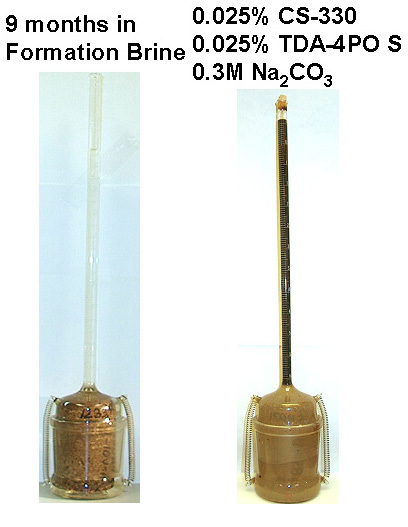During the 1990s, the members of the project team partnered to develop surfactant-enhanced aquifer remediation processes. The surfactant/foam aquifer remediation process recovered all or more DNAPL contaminant than thought to be present every time it was applied. In 1999, Dr. Hirasaki (principal investigator, Rice University) partnered with Dr. Mukul Sharma (University of Texas) in the DOE project Characterization of Mixed Wettability States and Its Impact on Oil Recovery (DE-AC26-99BC15205). In that project, the benefit of wettability alteration and ultralow interfacial tension for spontaneous oil displacement from fractured, oil-wet, carbonate formations was recognized. The present team partnered to combine the collective experience over the past 30 years in surfactant EOR.
Project Results
A surfactant-polymer formulation is being developed for a West Texas carbonate reservoir that has a pressure too low for CO2 flooding. The formulation has recovered up to 95% of the oil remaining after waterflooding in reservoir formation core material. The project team has met with the operator and partners to plan for a field test.
An alkaline-surfactant process is being developed for a fractured, oil-wet, carbonate reservoir in West Texas. The oil-wet character of the crude oil/brine/rock system is such that an oil-saturated core placed under formation brine does not recover any oil by spontaneous imbibition. However, when the brine is replaced by an alkaline surfactant solution, oil is spontaneously displaced by gravity drainage. The alkaline surfactant solution both alters wettability and reduces interfacial tension to ultralow values. Thus it overcomes the capillary retardation forces and permits the oil to flow by buoyancy or gravity drainage. The original operator of the field sold the field to another company, and the latter has less interest in surfactant EOR.
Benefits
This project is developing surfactant EOR processes for companies that do not have an in-house research capability. The oil recovery from laboratory experiments for the surfactant-polymer process is far greater than the best recovery achieved by a vendor contracted by the operator. Developing efficient EOR processes and making the knowledge available to the industry will result in increased oil recovery from the mature oil reservoirs that are nearly depleted by conventional waterflooding. This will aid the economy of Texas and reduce the dependency of the United States on imported crude oil.
Project Summary
Project researchers have:
- Developed surfactant formulations capable of efficient tertiary oil recovery in carbonate formations at low temperatures.
- Recognized that the adsorption of anionic surfactant on carbonate minerals can be significantly reduced in the presence of sodium carbonate.
- Identified the dependence of the optimal salinity of alkali-surfactant formulations on the ratio of the naphthenic soap/synthetic surfactant.
- Described the mechanisms controlling the length of the ultralow interfacial tension region during displacement of the alkali/surfactant/polymer (ASP) processes.
- Demonstrated that the sweep of heterogeneous fracture systems with surfactant solution is much more efficient when the surfactant solution is injected as foam.
- Scheduled a single-well field trial in a West Texas carbonate formation for January 2006. This test will be evaluated with tracers. This is a surfactant-polymer process with surfactants that are especially tolerant to divalent ions. Up to 95% of the waterflood residual oil was recovered from reservoir core floods.
- Developed a strategy for designing ASP flooding. Recovery of 98% of the water-flooded residual oil in dolomite is possible with a 0.5 pore volume surfactant slug with only 0.2% surfactant.
- A blend of two surfactants was found to form single-phase solutions over a higher salinity or calcium concentration ranges than either surfactant alone.
- Ultra-low interfacial tension (<10-2 mN/m) was found over a much wider range of salinity than expected for one ASP and crude oil combination.
The project team is developing surfactant EOR processes for both forced displacement and for spontaneous displacement by gravity from matrix blocks surrounded by fractures. Surfactants have been selected to have tolerance to divalent ions such that the systems can be applied in carbonate formations. These have branched hydrocarbon with an ethoxylated or propoxylated sulfate head group. The low temperature of shallow carbonate reservoirs often results in surfactants forming liquid crystal phases and gels rather than microemulsion. Addition of alcohol aids in formation of microemulsion. However, alcohols increase the minimum interfacial tension at optimal conditions. Highly branched internal olefin sulfonate cosurfactants are effective in reducing the alcohol requirement.




